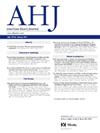急性失代偿性心力衰竭住院治疗期间利尿剂滴定模式。
IF 3.7
2区 医学
Q1 CARDIAC & CARDIOVASCULAR SYSTEMS
引用次数: 0
摘要
导读:急性失代偿性心力衰竭(ADHF)的住院率有所增加,导致每年650万住院日。尽管如此,管理ADHF的最佳利尿剂策略仍然不清楚,强调需要分析ADHF治疗中利尿剂的实践模式。方法:我们对2014年1月1日至2021年12月21日期间因ADHF住院的成人进行回顾性队列分析,不考虑左室射血分数(LVEF),以确定利尿剂的使用模式。我们进行了多变量回归分析,以评估首次、第二次和最大利尿剂治疗时间与住院时间(LOS)和30天再入院时间。结果:在4298名ADHF患者中(平均年龄63岁,62%为男性,52% LVEF≤40%),达到最大利尿剂治疗的中位时间为1.8(0.7,3.8)天。到第一次静脉循环利尿剂剂量的中位时间为3.6(2.1,6.5)小时,到第二次静脉循环利尿剂剂量的中位时间为10.2(6.3,15.1)小时。首次静脉注射利尿剂的时间,第二次静脉注射利尿剂的时间,以及达到最大利尿剂治疗的时间都与LOS增加呈正相关,但与30天再入院无关。在循环利尿剂升级策略和序贯肾元阻断的使用上存在很大的差异。结论:同一学术医疗中心的利尿策略差异很大。初始静脉袢利尿剂使用时间的增加、利尿剂剂量间隔时间的增加以及利尿剂最大剂量使用时间的延长与LOS增加有关,但与30天再入院无关,这表明不同的利尿剂策略可能影响患者的预后,值得将来进行专门的研究。本文章由计算机程序翻译,如有差异,请以英文原文为准。
Patterns of diuretic titration during inpatient management of acute decompensated heart failure
Introduction
Hospitalization rates for acute decompensated heart failure (ADHF) have increased, resulting in 6.5 million hospital days annually. Despite this, optimal diuretic strategies for managing ADHF remain unclear, highlighting the need to analyze diuretic practice patterns in ADHF treatment.
Methods
We performed a retrospective cohort analysis of adults hospitalized for ADHF, regardless of left ventricular ejection fraction (LVEF) between January 1, 2014 and December 21, 2021 at a large, quaternary healthcare system to determine diuretic practice patterns. We performed multivariable regression analyses to assess time to initial, second, and maximum diuretic therapy with hospital length of stay (LOS) and 30-day readmission.
Results
Among 4,298 adults admitted for ADHF (mean age 63 years, 62 % male, 52 % LVEF ≤40 %) median time to max diuretic therapy was 1.8 (0.7, 3.8) days. Median time to initial IV loop diuretic dose was 3.6 (2.1, 6.5) hours, while time to second dose of IV loop diuretic dose was 10.2 (6.3, 15.1) hours. Time to initial IV loop diuretic, time to second IV loop diuretic dose, and time to maximum diuretic therapy were all positively associated with increased LOS but were not associated with 30-day readmission. There was wide variation in loop diuretic escalation strategies and use of sequential nephron blockade.
Conclusion
There was wide variation in diuretic strategies at a single academic medical center. Increased time to initial IV loop diuretic, time between diuretic doses, and longer time to max diuretic therapy were associated with increased LOS but were not associated with 30-day readmission suggesting different diuretic strategies may affect patient outcomes and warrant dedicated investigation in the future.
求助全文
通过发布文献求助,成功后即可免费获取论文全文。
去求助
来源期刊

American heart journal
医学-心血管系统
CiteScore
8.20
自引率
2.10%
发文量
214
审稿时长
38 days
期刊介绍:
The American Heart Journal will consider for publication suitable articles on topics pertaining to the broad discipline of cardiovascular disease. Our goal is to provide the reader primary investigation, scholarly review, and opinion concerning the practice of cardiovascular medicine. We especially encourage submission of 3 types of reports that are not frequently seen in cardiovascular journals: negative clinical studies, reports on study designs, and studies involving the organization of medical care. The Journal does not accept individual case reports or original articles involving bench laboratory or animal research.
 求助内容:
求助内容: 应助结果提醒方式:
应助结果提醒方式:


